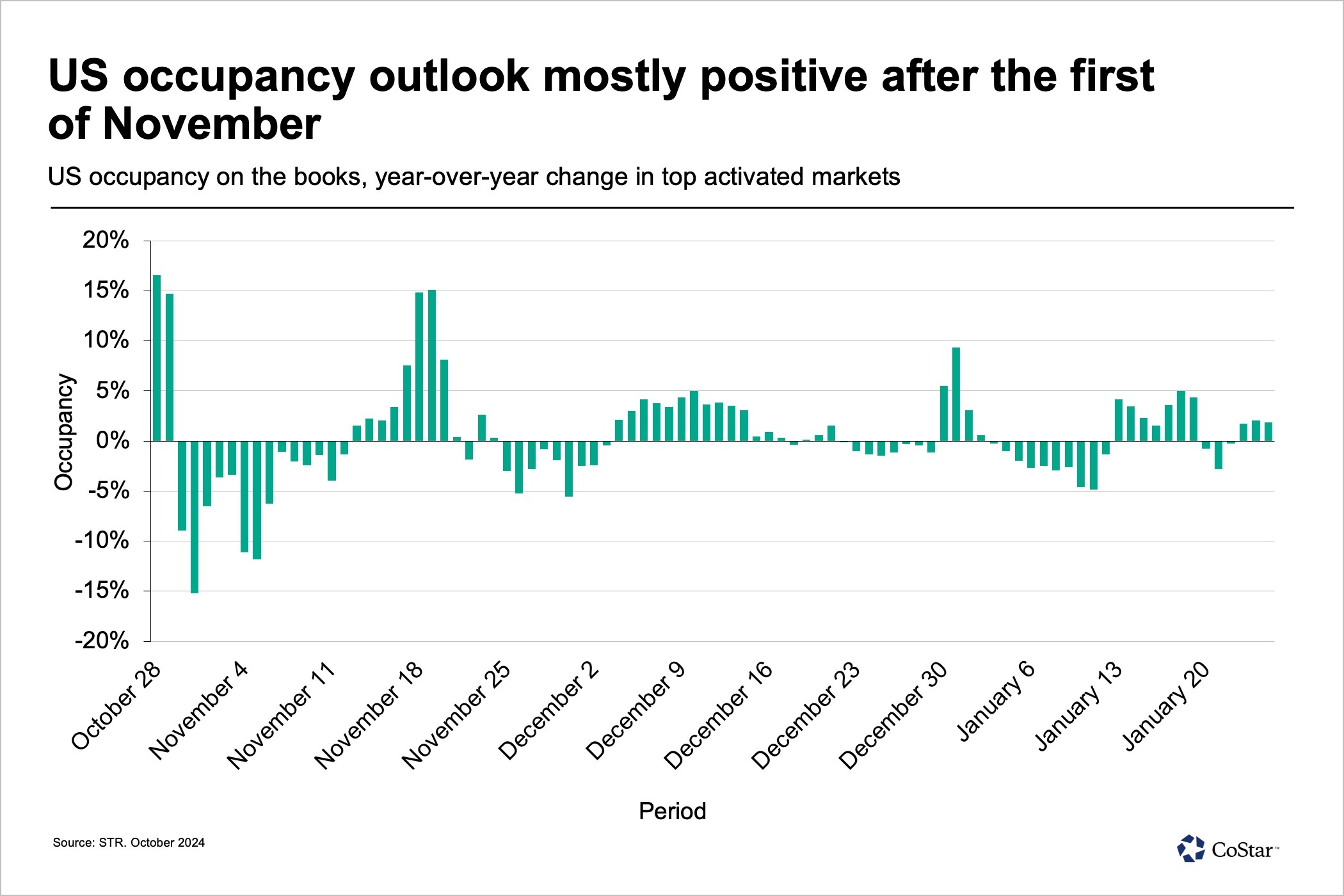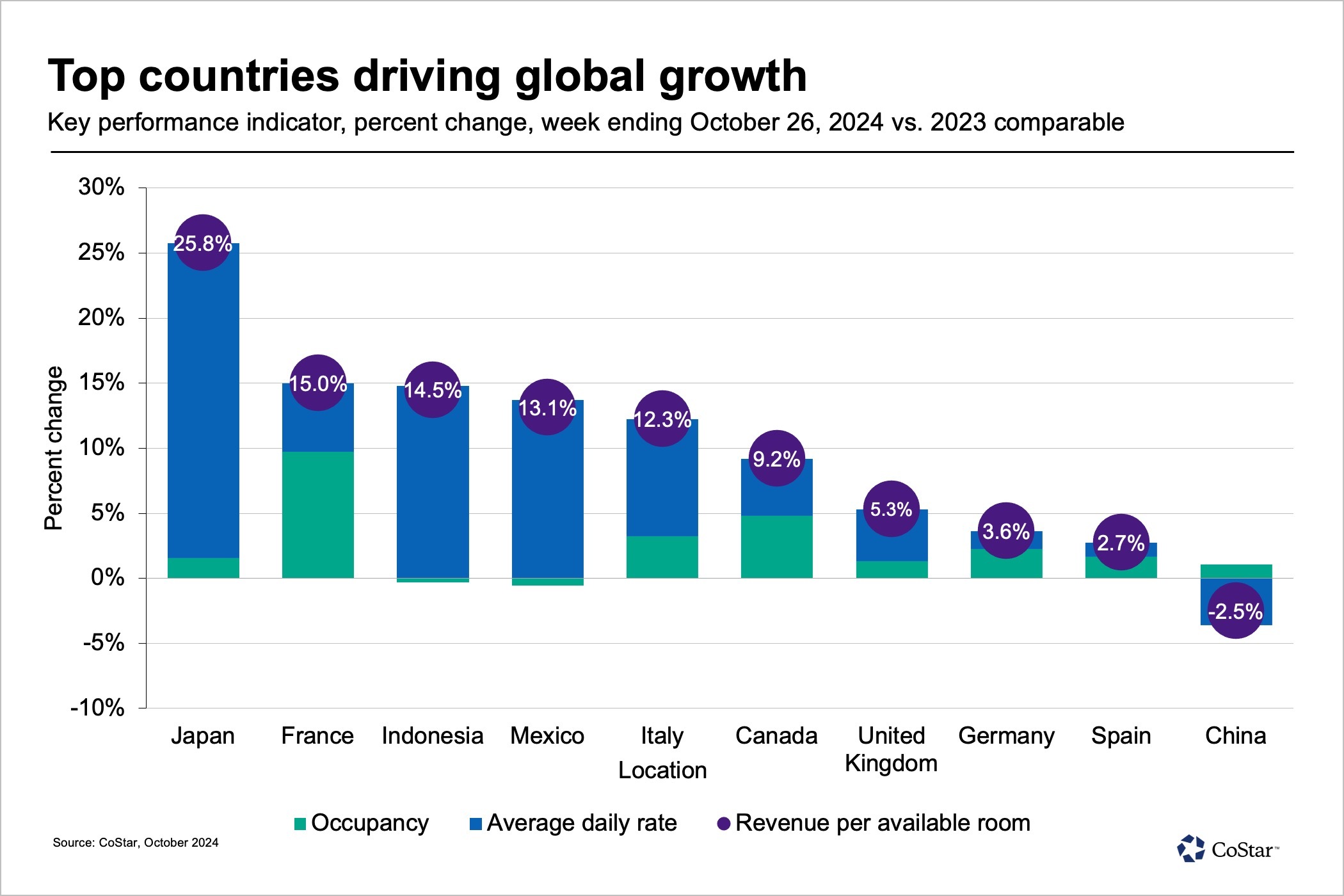The week of Oct. 20-26 was a clean week with no calendar or holiday shifts to distort the performance of U.S. hotels. The last full week of October achieved hotel demand gains from ongoing hurricane recovery efforts, Taylor Swift, college football, and the squeezing in of conferences and meetings ahead of Halloween and the election.
U.S. hotel revenue per available room grew 9.3% year over year on nearly equal gains in occupancy and average daily rate. Hotel occupancy reached 69%, up 3 percentage points, and ADR increased 4.6%. The occupancy gain was the largest since earlier this year with 82% of the 171 STR-defined U.S. markets reporting occupancy growth, the most of the past 91 weeks.
Demand numbers
More than 27.2 million hotel rooms were sold during the week, which was higher than what was sold during the comparable week in 2019 and 1.3 million more than a year ago. Nearly half of the week’s demand increase came from hotel markets in the South. The largest demand gainers were in areas affected by Hurricane Helene and Hurricane Milton, including Augusta, Georgia; Sarasota, Florida; Florida Central South; Tampa; Columbia, South Carolina; and South Carolina Area. Hotel demand and RevPAR growth in these markets exceeded 20%. Even though demand was up year over year, hotel occupancy (69%) was lower from the prior week (70%), which is normal based on the three times with the same calendar composition since 2000.
Hotel demand was up in all regions, but with a higher ADR growth rate, the Northeast led the country again in RevPAR growth (+12.5%) followed by the Midwest (+11.9%) and the South (+10.5%) with the West trailing (+5.1%). The highest RevPAR gains in the Northeast were in tertiary markets such as Rhode Island and Massachusetts Area. The three top 25 markets in the Northeast – Boston, New York City, and Philadelphia – saw slightly stronger RevPAR growth in aggregate (+13.4%) than the remaining markets (+10.6%) due to stronger ADR gains (+9% vs. +4.6%). The ADR growth disparity between the top 25 and all other markets played out across three of the four regions with the West being the exception. ADR growth for the nine western top 25 markets collectively was up 1% versus 3.5% for the remaining markets. The region was held back by San Francisco and Las Vegas, where ADR declined.
While the South saw increased hotel demand from recent hurricanes, several of the region’s markets reported a significant lift in ADR, including New Orleans, which benefited from Taylor Swift’s Eras Tour. For the week, New Orleans ADR increased 64.1%, the most of any market. Weekend ADR on Friday and Saturday in New Orleans jumped 147.7%, resulting in the nation’s highest weekend ADR ($489). In the days prior to the concerts between Sunday and Wednesday, New Orleans ADR was up just 0.6% year over year.
Greensboro/Winston Salem, North Carolina, followed New Orleans with the next highest weekly hotel ADR increase (+41.3%) with its weekend ADR up 72.3% on strong demand gains due in part to various events in the market.
College football also drove hotel performance across the nation. Tuscaloosa saw the largest weekend RevPAR increase of any submarket with the measure rising 649.3% on a 386.3% ADR lift due to the Missouri-Alabama game. The market’s weekend ADR ($508) was comparable to that of Maui and Key West. In the submarkets that hosted a top 10 team this week, RevPAR was up 22.7% on rising ADR.

Group demand among luxury and upper-upscale hotels increased 7.3% after falling in the previous three weeks. Absolute demand reached 2.4 million rooms sold, its highest level of the year thus far. Demand was equal to the comparable week in 2019, but below 2019’s peak, which occurred in spring of that year. In 2023, the peak occurred a week earlier, but this year’s level surpassed it. Group demand was up across most markets and was led by Augusta. Group ADR increased by 4% in the week.
Given the strength in group demand, it’s not surprising that luxury and upper-upscale hotels saw strong RevPAR growth. What is surprising is that five of the seven chain scales saw RevPAR increases above 9%. Economy (+6.9%) and independent (+5.4%) hotels were the only segments below that percentage. Additionally, all chain scales have posted growth in the past three consecutive weeks and in four of the past five weeks.
For the third consecutive week, New York City led the nation in absolute occupancy (92.7%) followed by Boston (89.8%). The next three highest occupancy levels were seen in cities directly or indirectly affected by the recent hurricanes: Greenville/Spartanburg, South Carolina (89.7%), Tampa (84.2%) and Augusta (84.1%). Midtown West/Times Square and Midtown South led submarkets in occupancy (94.1%) with two other New York submarkets claiming third and fourth place. The fifth highest submarket occupancy was seen in Nashville Central Business District (92.7%). This submarket has been above 90% for the past three weeks, a claim that only seven other submarkets can make, all of which are in New York.
Overall U.S. weekend RevPAR increased 12.2%, which was largest increase since spring with the growth evenly split between occupancy and ADR. Even if you exclude New Orleans, weekend RevPAR was strong (+10.3%), meaning Taylor Swift drove nearly two percentage points of the U.S. weekend RevPAR gain. RevPAR on weekdays Monday to Wednesday increased 7.4% and on shoulder days Sunday and Thursday increased 8.9%.
The weeks ahead
Travel compression ahead of Halloween and the election along with key college football matchups and fall travel drove strong U.S. hotel demand in the week and will lead to solid RevPAR for the month of October. Looking ahead, the next two weeks will be much different in the U.S. given Halloween and the election. We expect to see positive RevPAR comparisons in November, but much less than what is predicted for October.

Global hotels sprint ahead
Excluding the U.S., global hotel RevPAR during the week of Oct. 20-26 advanced 10.2% mostly on ADR gains (+7.2%). Occupancy increased nearly two percentage points to 72.6%, with the level almost the same as it was a week ago. Weekdays and shoulder days produced the largest RevPAR increases, each in double-digits, with ADR showing no variation between the day types. Weekend RevPAR, while lower than the other day types, was still formidable, rising 8% – like its growth in the prior week. Global RevPAR including the U.S. still increased 9.9%.
Demand outside the U.S. increased by more than 3.3 million rooms with 75% of countries seeing growth, led by China, which accounted for more than a fifth of that gain. Nearly half of the demand growth came from the top 10 largest countries including Canada, France, Germany, Japan, Spain and the United Kingdom.

Strong hotel RevPAR growth was seen in Japan, led by Kyoto and Tokyo, each seeing gains of more than 30%. France also had strong RevPAR growth driven by markets outside of Paris. Paris, which accounts for most of the weekly sample, was up 4.3%, all on occupancy as ADR declined. Mexico continued to see ADR-driven RevPAR increases. RevPAR in the Mexican Caribbean, which has the most rooms of any market in the region, saw RevPAR move up 10.1% on a 16.8% ADR increase. Canadian RevPAR increased 9.2%, returning to positive territory after the Thanksgiving slowdown in the previous week.
While China led the globe in room demand growth, RevPAR for the week fell 2.5% as ADR dropped 3.6%. Double-digit ADR decreases were seen in Fuzhou, Hainan, Hong Kong, Qingdao, and others. Occupancy in China stood at 72.6% and has been above 70% in three of the past four weeks.
The rest of the world will also see a slowing in hotel performance the week of Oct. 27 to Nov. 2, with acceleration in performance in the first full week of November.
Isaac Collazo is vice president of analytics at STR.
This article represents an interpretation of data collected by CoStar's hospitality analytics firm, STR. Please feel free to contact an editor with any questions or concerns. For more analysis of STR data, visit the data insights blog on STR.com.
